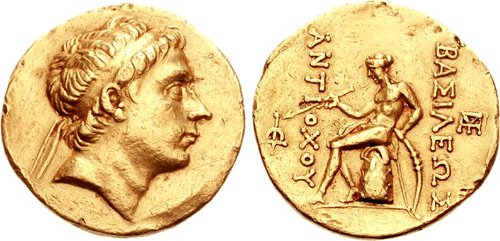
Even today portrait art is meant to glorify the subject. The person portrayed is somehow worthy of having their image publicly disseminated. Cameras and social media have compromised technique as anyone can take a great portrait shot and post it anywhere. Images are all commonly reduced to worthless noise.
2500 years ago, images were the province of the technically gifted. Painters, Celators, Sculptors labored for months to produce extraordinarily artful renditions. And before Alexander the Great Portraits were the province of Deity. If men were depicted, they were depicted as Heroes: Gods on Earth, and portraits conflated their features with those of the Gods.
It was not until after the death of Alexander the Great that men were realistically portrayed on coins. The first portraits were of Alexander himself. Executed in the workshops of Philip III, (Alexander's half brother), they portrayed Alexander in order to establish Philip's right to the throne through Lineage. However, once the taboo on human portraiture had been broken, the artists working at Philips's various mints began to execute an array of portraits, all of which have yet to be identified:

For example, who might this fellow be above? Certainly not Alexander. Could it be Philip III? Or perhaps a favorite uncle of the celator? Tough to say, though I would guess it's more likely to be Philip.
In Egypt, Ptolemy, one of Alexander's most powerful generals, began to mint coinage with his own image. Some extraordinary pieces were singed behind the ear by proud artists (like the portrait coin below signed by the artist D) This tradition continued throughout the course of Ptolemaic Egypt and yields some of antiquity's great gold portait coins. The famous Cleopatra VII if depicted on several coins of her era.

In Thrace Lysimachus, another powerful General of Alexander, also minted coins with the portrait of Alexander. Yet he too issued coins with other portraits, as did other rulers of Thrace right down to Roman times. They are all described as portraits of Alexander, but some clearly depict other unidentified officials.
 For example, who might this be? It doesn't look much like Alexander. Yet the fine style clearly suggests a specific individual. Could it be Lysimchos? Or could it be Lysimchos' features conflated with those of Alexander. It's certainly fun to speculate.
For example, who might this be? It doesn't look much like Alexander. Yet the fine style clearly suggests a specific individual. Could it be Lysimchos? Or could it be Lysimchos' features conflated with those of Alexander. It's certainly fun to speculate.Seleukos, another of Alexander's generals, took the Eastern provinces, and he also issued portrait coinage, mostly depicting Alexander. But his son Antiochus began to issue coins with the image of Seleukos; and there is an entire line of Seleuked portrait coinage, which, alas, is all extremely rare, for reasons that are not entirely clear.

It is quite extraordinary to be able to see portraits of these men who shaped the course of history. It must have been far more extraordinary at the time for common men and women to be able to see portraits of their rulers on these convenient, portable artworks. How strange it must have been to people for whom the only other images available would have been those depicting religious and mythological scenes in temples, and perhaps in the villas of the very rich.
Your article is amazing,just love it.you can visit my website :download pocket tank
ReplyDeleteI am thinking that in this time you should give a try to this new app Def Jam Fight for NY Apk : which is now most trending app in the world.
ReplyDelete